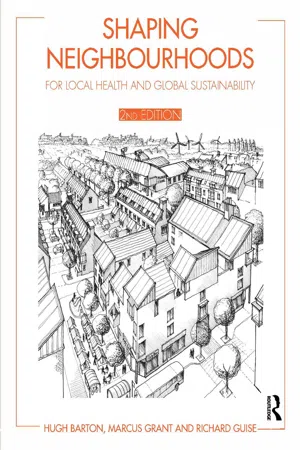
Shaping Neighbourhoods
For Local Health and Global Sustainability
Hugh Barton, Marcus Grant, Richard Guise
- 330 pages
- English
- ePUB (mobile friendly)
- Available on iOS & Android
Shaping Neighbourhoods
For Local Health and Global Sustainability
Hugh Barton, Marcus Grant, Richard Guise
About This Book
This substantially revised and important second edition comes at a pivotal time, with both a strong agenda of localism in planning and with public health professionals now realising the vital importance of shaping urban environments in order to reduce the burden of disease and support better health outcomes.
This guide ensures you:
- understand the underlying principles for planning healthy and sustainable neighbourhoods and towns
- plan the collaborative and inclusive processes needed for multi-sectoral cooperation
- develop know-how and skills in matching local need with urban form
- discover new ways to integrate development with natural systems
- design places with character and recognise good urban form
- guide communities, and advise developers, in the creation of successful and sustainable places for living.
Containing many new case studies and a wealth of new research, this new edition has benefited from previous user feedback. Shaping Neighbourhoods is the indispensable guide for bridging the gulf between theory and practice, between planning authorities, investors and communities, and between different professional perspectives.
Whether you are a student faced with a local planning project; a planner, urban designer or developer involved in new development; a health authority concerned with promoting physical activity; or a community group wanting to improve your neighbourhood; this book is for you.
Frequently asked questions
Information
Table of contents
- Cover
- Half Title
- Title
- Copyright
- Contents
- Acknowledgements
- Foreword
- How to use this manual
- Chapter 1 ORIENTATION AND PRINCIPLES
- Introduction
- 1.2 Re-inventing neighbourhoods
- Policies and agendas
- 1.3 Promoting sustainable development
- 1.4 Climate stability
- 1.5 Promoting healthy communities
- 1.6 The obesity issue
- 1.7 The great urban form debate
- The neighbourhood as habitat
- 1.8 The ecosystem approach
- 1.9 The settlement health map
- The neighbourhood in focus
- 1.10 Defining neighbourhoods
- 1.11 District/town, neighbourhood and home place
- 1.12 Neighbourhood design principles
- Case studies
- 1.a Freiburg, Germany
- 1.b East End, Glasgow
- Chapter 2 NEIGHBOURHOOD PLANNING PROCESS
- Overview
- 2.2 The seven stage process
- 2.3 Collaborative communities
- Getting going
- 2.4 STAGE 1 - Taking the initiative
- 2.5 STAGE 2 - Defining a shared vision
- 2.6 Working with local people
- Creating a strategy
- 2.7 STAGE 3 - Understanding the locality
- 2.8 STAGE 4 - Developing ideas
- 2.9 STAGE 5 - Agreeing a co-ordinated programme
- Making it happen
- 2.10 STAGE 6 - Taking action
- 2.11 Making a development proposal
- 2.12 STAGE 7 - Learning lessons
- Case studies
- 2.a Houndwood, Street, Somerset
- 2.b Sherford Valley, Plymouth
- Chapter 3 PROVIDING FOR LOCAL NEED
- 3.1 Purpose and scope
- People and community
- 3.2 A diverse population
- 3.3 Housing for all
- 3.4 Developing social capital
- 3.5 Neighbourhood identity
- Local enterprise
- 3.6 Access to jobs
- 3.7 Resilient local economies
- Access to local facilities
- 3.8 Planning local accessibility
- 3.9 Accessibility criteria
- 3.10 Local shops and services
- 3.11 Town centre vitality
- 3.12 Schools
- 3.13 Community health
- 3.14 Recreational open space
- Planning for movement
- 3.15 Neighbourhood movement strategy
- 3.16 Planning for the pedestrian
- 3.17 Planning for the cyclist
- 3.18 Public transport operation
- 3.19 Planning for the car
- Case studies
- 3.a Vauban, Freiburg, Germany
- 3.b Telford Millennium Community
- Chapter 4 WORKING WITH NATURAL SYSTEMS
- Overview
- 4.2 Implementing an integrated strategy
- Energy
- 4.3 Energy system basics
- 4.4 Neighbourhood energy planning
- 4.5 Energy efficient layout and landscape
- 4.6 Sourcing and distributing energy
- Water
- 4.8 Neighbourhood water planning
- 4.9 Local supply and treatment
- 4.10 Flooding, drainage and run-off
- Food
- 4.11 Food basics: staple issues
- 4.12 The neighbourhood food plan
- 4.13 Local food supply and access
- 4.14 Food growing
- Materials
- 4.16 Local materials management
- 4.17 Local resource recovery
- Biodiversity
- 4.18 Wildlife: a health issue?
- 4.19 Local biodiversity and wildlife planning
- 4.20 Biodiversity framework
- 4.21 Urban trees
- 4.22 Biodiversity and the development project
- Case studies
- 4.a Hammarby Sjostad, Sweden
- 4.b Vestebro, Copenhagen
- Chapter 5 NEIGHBOURHOOD DESIGN
- Overview
- 5.2 Devising the spatial framework
- Key spatial elements
- 5.3 A mix of uses
- 5.4 Graded density
- 5.5 Street networks
- 5.6 The green infrastructure
- Assessing problems and opportunities
- 5.7 The scope of neighbourhood appraisal
- 5.8 Urban potential studies
- 5.9 Analysing form and function
- Shaping settlements
- 5.10 Land needs
- 5.11 Designing neighbourhood cells
- 5.12 Linear districts and towns
- Neighbourhood regeneration
- 5.13 Change and renewal
- 5.14 Intensification
- Designing places
- 5.15 Design of the public realm
- 5.16 Perimeter block and home place
- 5.17 Urban design framework
- Case studies
- 5.a Redcliffe, Bristol, England
- 5.b Newcastle Great Park, England
- Chapter 6 NEIGHBOURHOOD CHECKLISTS
- 6.1 Neighbourhood decision-making
- 6.2 People and community
- 6.3 Access to local facilities and jobs
- 6.4 Planning for movement
- 6.5 The greenspace system
- 6.7 Urban form
- 6.8 Urban design
- Development checklist
- 6.10 The process of decision-making
- 6.11 Choosing the right location
- 6.12 Site and context appraisal
- 6.13 Neighbourhood health and sustainability impact
- Bibliography
- Index and key terms